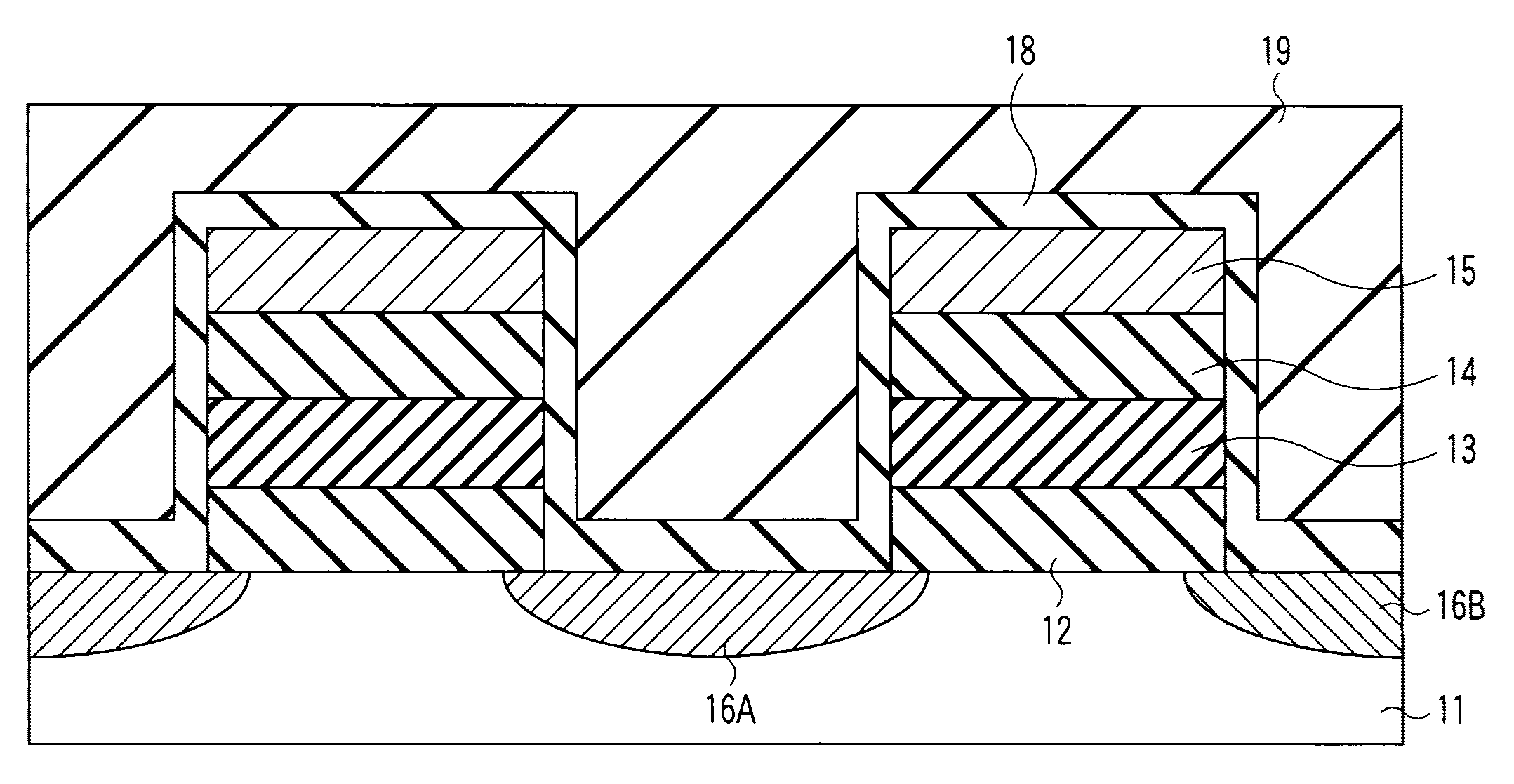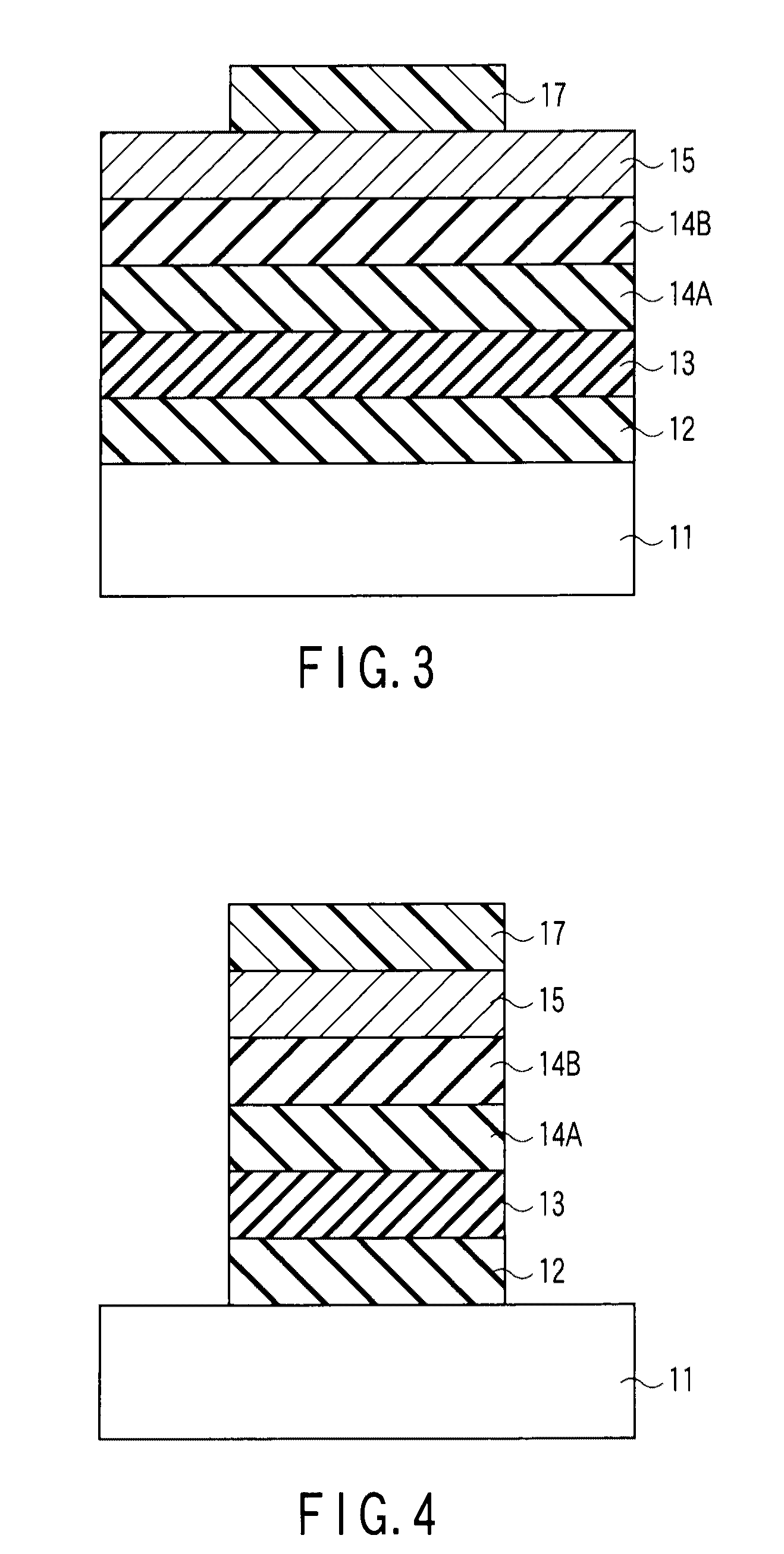Nonvolatile semiconductor memory element and manufacturing method thereof
a semiconductor memory element and non-volatile technology, applied in the direction of semiconductor devices, electrical devices, transistors, etc., can solve the problems of limited tunnel insulating layer formation, limited thin film formation, and difficult miniaturization
- Summary
- Abstract
- Description
- Claims
- Application Information
AI Technical Summary
Problems solved by technology
Method used
Image
Examples
first embodiment
[0037]FIG. 1 is a sectional view illustrating a memory cell transistor (a nonvolatile semiconductor memory element) according to the first embodiment.
[0038]A p-type-conductivity substrate 11 is, for example, a p-type semiconductor substrate, a semiconductor substrate with a p-well, or an SOI (Silicon On Insulator) substrate with a p-type semiconductor layer. A semiconductor made of silicon (Si) or the like, or a compound semiconductor made of SiGe, GaAs, ZnSe, or the like is used as the semiconductor substrate 11.
[0039]In the semiconductor substrate 11, a source region 16A and a drain region 16B are provided separately. Each of the source region 16A and drain region 16B is composed of an n+-type diffused region formed by introducing highly-concentrated n+-type impurities (such as phosphorus (P) or arsenic (As)) into silicon.
[0040]On the semiconductor substrate 11 between the source region 16A and drain region 16B (that is, on the channel region), there is provided a gate structure i...
second embodiment
[0069]The second embodiment suppresses the reaction of the charge storage layer with the lanthanum aluminate layer more by inserting stabilized aluminum oxide between the charge storage layer and the lanthanum aluminate layer as a part of the block insulating layer. FIG. 9 is a sectional view illustrating a memory cell transistor according to the second embodiment.
[0070]In a semiconductor substrate 11, a source region 16A and a drain region 16B are provided separately. On the semiconductor substrate 11 between the source region 16A and drain region 16B (that is, on the channel region), there is provided a gate structure in which a tunnel insulating layer 12, a charge storage layer 13, a block insulating layer 14, and a control gate 15 are stacked one on top of another in that order.
[0071]The block insulating layer 14 has a stacked structure in which an aluminum oxide layer 14A and a lanthanum aluminate layer 14B are stacked one on top of the other in that order. The lanthanum alumin...
third embodiment
[0086]The third embodiment suppresses the reaction of the charge storage layer with the lanthanum aluminate layer more by inserting stabilized aluminum oxide between the charge storage layer and a lanthanum aluminate layer as a part of the block insulating layer. Moreover, the third embodiment suppresses the reaction of the control gate electrode with the lanthanum aluminate layer more by the insertion of stabilized aluminum oxide between the control gate electrode and the lanthanum aluminate layer. FIG. 16 is a sectional view illustrating a memory cell transistor according to the third embodiment.
[0087]In a semiconductor substrate 11, a source region 16A and a drain region 16B are provided separately. On the semiconductor substrate 11 between the source region 16A and drain region 16B (that is, on the channel region), there is provided a gate structure in which a tunnel insulating layer 12, a charge storage layer 13, a block insulating layer 14, and a control gate 15 are stacked on...
PUM
 Login to View More
Login to View More Abstract
Description
Claims
Application Information
 Login to View More
Login to View More - R&D
- Intellectual Property
- Life Sciences
- Materials
- Tech Scout
- Unparalleled Data Quality
- Higher Quality Content
- 60% Fewer Hallucinations
Browse by: Latest US Patents, China's latest patents, Technical Efficacy Thesaurus, Application Domain, Technology Topic, Popular Technical Reports.
© 2025 PatSnap. All rights reserved.Legal|Privacy policy|Modern Slavery Act Transparency Statement|Sitemap|About US| Contact US: help@patsnap.com



